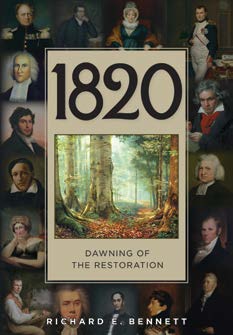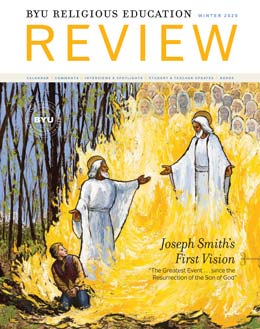1820: Dawning of the Restoration
Emily Cook
Emily Cook (cookemily@gmail.com) was a student editor at the Religious Studies Center when was written.
The year 2020 is one of great religious significance. It is the two hundredth anniversary of Joseph Smith’s First Vision. This is sure to be a year of gratitude as members around the world celebrate and reflect on the blessings of the Restoration of the gospel of Jesus Christ. As part of this celebration and reflection, Richard Bennett has compiled years of research into his soon-to-be-published book 1820: Dawning of the Restoration.

The book looks at what he calls the “four cornerstones”[1] of the early nineteenth century: revolution and reform, Romanticism, emancipation, and religious revivalism. In order to illustrate the significance of these cornerstones, Bennett narrows in on remarkable figures in each of these movements during this era.
In regard to revolution and reform, Bennett spotlights prominent political figures such as the French emperor Napoléon and the British king and queen George IV and Caroline. Bennett describes how Napoleon’s conquests spread progressive ideals across the globe and how the Industrial Revolution began to change the world right under the noses of the quarrelling British monarchs.
Additionally, figures such as the master musician Beethoven and the tormented artist Géricault are recognized for their work in Romanticism. Both strove to capture human emotion through music and painting while they simultaneously made pointed political statements.
The early 1800s was also an age of emancipation. The Venezuelan revolutionary Simón Bolívar fought for South American independence from European powers. Bennett describes how it was through Bolívar’s persistence that South America was set on the path of freedom from the tyranny of Spain and Portugal.
Bennett shows the important role religious revivalism played during this age through describing the lives of people such as William Wilberforce and Reverend John Williams. William Wilberforce was a convert of Methodist revivals in Great Britain, and his religious convictions eventually inspired him to work to abolish the slave trade. Rev. Williams was a member of the London Missionary Society that preached Christianity throughout the South Pacific, Asia, and Africa.
Bennett acknowledges that taking on the task of writing 1820 came with daunting challenges, including interpretation, historical context, and scope. However, he tackles these challenges by weaving together the biographies of these extraordinary people to give readers a glimpse into the “spirit of the age.”[2]
Bennett’s objective in writing 1820 was not to prove that the only purpose of these noteworthy events and people was to prepare the world for the Restoration: “A worldwide history cannot be artificially bent to fit a narrow, preconceived, faith-promoting paradigm of interpretation and self-fulfilling prophecy, that everyone and everything were somehow all part of a divine Latter-day Saint hymnbook.” He states, “Some of what was happening elsewhere did indeed impact the unfolding of the Restoration, and where that was the case, I have briefly made comments thereon. However, this was not always so. The astute reader will have to make his or her own connections and conclusions.”[3]
Readers of 1820 will gain greater insight into the exciting and dynamic era of 1820. In the book, Bennett shows that “while the answer to [Joseph Smith’s] prayer led to the sunrise of a new world religion, his quest must also be seen as part of a time that was changing old ways, mannerisms, and streams of thought in a wide range of human endeavor. It was a time that fostered new revolutions in politics, economics, the arts, science, and religion.”[4] Such an awareness of the Restoration’s place in history can only encourage a deeper sense of appreciation among Church members for the restoration of Christ’s church on the earth and the blessings of salvation for the human family that have come from it.
Notes
[1] Richard E. Bennett, 1820: Dawning of the Restoration (Provo, UT: Religious Studies Center, Brigham Young University; Salt Lake City: Deseret Book, 2020), xi.
[2] Bennett, 1820, xiii.
[3] Bennett, 1820, viii.
[4] Bennett, 1820, xiv.
